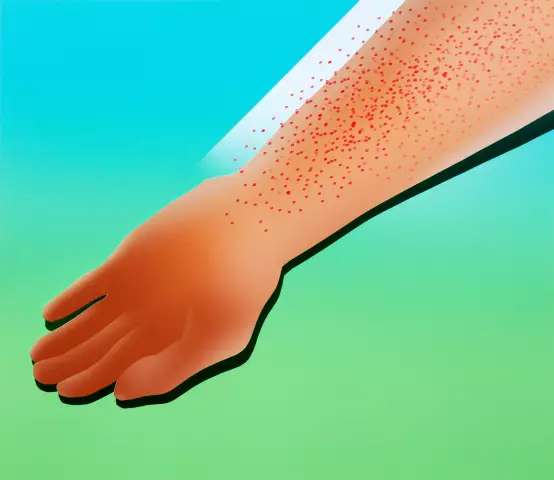- Author Rachel Wainwright [email protected].
- Public 2023-12-15 07:39.
- Last modified 2025-11-02 20:14.
Erythrocytes in the urine of a child

Red blood cells are red blood cells of the blood. They carry oxygen, providing metabolism, simply - nutrition of the body's cells. With blood loss, erythrocytes become smaller, a state of anemia occurs. When the bleeding is caused by a wound, it can be stopped by bandaging. It is much more difficult if the red blood cells are lost in the urine. This condition is more common in children than in adults. The appeared erythrocytes in the urine of a child indicate a number of pathological conditions and diseases.
How red blood cells appear in the urine of a child
In the glomerular apparatus of the kidneys, blood is filtered. Cellular elements remain, and the fluid undergoes additional processing. When the concentration of urine reaches a certain limit, the formed fluid is excreted. Routes of urine excretion:
- Renal pelvis;
- Ureters;
- Bladder;
- Urethra.
Erythrocytes in the urine of a child can appear at any stage of its elimination, or at the time of blood filtration.
The opening of the kidney filter is 8 nanometers, while the diameter of the mature erythrocyte always exceeds this size. There are only two reasons why red blood cells end up in a baby's urine. This is the reduced size of the red blood cell, or the expansion of the filter opening in the kidney tissue.
In the course of the urethra, erythrocytes in the urine appear due to their ingress from the affected tissues of the renal pelvis, ureters, bladder and genitals. In such cases, we are not talking about true blood loss, but about untrue hematuria, when blood impurities get into normal urine.
The norm of erythrocytes in the urine of the child
It is considered normal to detect 2-4 erythrocytes in the child's urine in the field of view of the laboratory assistant. When the cells are examined in detail, they are damaged: they have lost their membrane as a result of the natural aging process. The life span of an erythrocyte cell is 120 days. The formation of new red blood cells occurs daily, so there can be no question of any blood replacement. So, altered red blood cells in the urine can appear not only once every 120 days, but much more often.
All other indicators are not regarded as the norm of red blood cells in the child's urine, even if the red blood cells, every single one, are changed. But if their number exceeds 4 in the field of view, one should look for the reasons for their massive death.
The reasons why there are increased red blood cells in the urine of a child
There are two types of reasons why erythrocytes appear in the urine of a child, however, like an adult.
The first group is called reactive states, which lead to general intoxication of the body, as a result of which the openings of the kidney filters expand:
- Viral infections, accompanied by a significant increase in body temperature (ARVI, most often, influenza). When heated, each item expands, so does the kidney filters;
- Meningitis, typhoid fever, severe intestinal infections;
- Poisoning with toxins in sepsis.
Red blood cells may appear in the urine of a child after prolonged physical activity, when he has to walk for a long time. This is the so-called "marching hematuria", which passes without a trace during the day.
The second group of reasons why increased erythrocytes in the urine of a child are detected are diseases that directly relate to the urinary and urinary tract:
- Glomerulonephritis is a direct lesion of the renal glomeruli. A hallmark of glomerulonephritis is the appearance in the urine of not only erythrocytes, but also cylinders with blood proteins;
- Pyelonephritis - the expansion of filtration pores occurs due to inflammatory edema. With pileonephritis, leukocytes are necessarily found in the urine - cells that indicate an inflammatory process;
-
Urolithiasis is a rare childhood pathology in which red blood cells in the urine appear from any part of the urethra: from the renal pelvis to the urethra;
- Inflammation of the bladder - cystitis.
- Damage to the mucous membrane of the urethra - urethritis.
The most common reasons why red blood cells are found in the urine of a child are kidney or bladder injuries.
A rather rare, but most formidable pathology is kidney cancer.
False hematuria
Non-true hematuria is diagnosed when the red blood cells in the child's urine are not full red blood cells. But false hematuria has nothing to do with diseases of both the kidneys and the body as a whole.
When examining a urine test in a microscope, it is not cells that fall into the field of view of the laboratory assistant, but fragmented spots of coloring pigments. A similar condition occurs after eating beets. In this case, the urine is stained to the color of blood. Her medicines stain her somewhat weaker:
- Vitamin B 12;
- Sulfonamide group preparations;
- Analgin and aspirin;
- Phenolphthalein.
Erythrocytes in the urine of adolescent girls may be due to menstrual bleeding when mixed with the contents of the vagina.
How to collect an analysis so that red blood cells in urine do not accidentally happen
Any positive test for red blood cells in the urine of a child is alarming not only for parents, but also for health workers. In order to avoid unpleasant incidents, each parent needs to know the rules for collecting urine, which provide for the following conditions:
- The collection of analysis should be done in the morning, when the child's urine is most concentrated;
- It makes no sense to take an analysis after physical activity, the "march test" in young children "works" much more often than in adults and adolescents.
It is necessary to teach girls how to collect urine correctly, regardless of whether they have a period at that moment. First, you need to wash the genitals. This will save not only the accidental ingestion of red blood cells, but also leukocytes. Secondly, it should be borne in mind that the most informative portion of urine is average, which is considered not by quantity, but has a qualitative characteristic. Having passed the first portion of urine, it is necessary to put the test jar under the stream without interrupting it. Otherwise, the collected urine will again indicate the first portion in which the contents of the vagina are present. Whatever amount of urine is collected according to these rules, it will be considered an average portion. The last portion of urine is in the ureters, and it can only be collected in a hospital setting.
When a child needs urine tests

In addition to routine tests when visiting a children's clinic, the indications for urine tests in children are the following conditions:
- Child complaints about pain during urination;
- Frequent urination;
- Pain in the lower abdomen and lower back;
- Brown staining of urine.
If such conditions occur at night, in the morning you should collect a urine test and take it to the doctor's office, without waiting for a written referral. You can get it immediately at the reception.
YouTube video related to the article:
Found a mistake in the text? Select it and press Ctrl + Enter.






